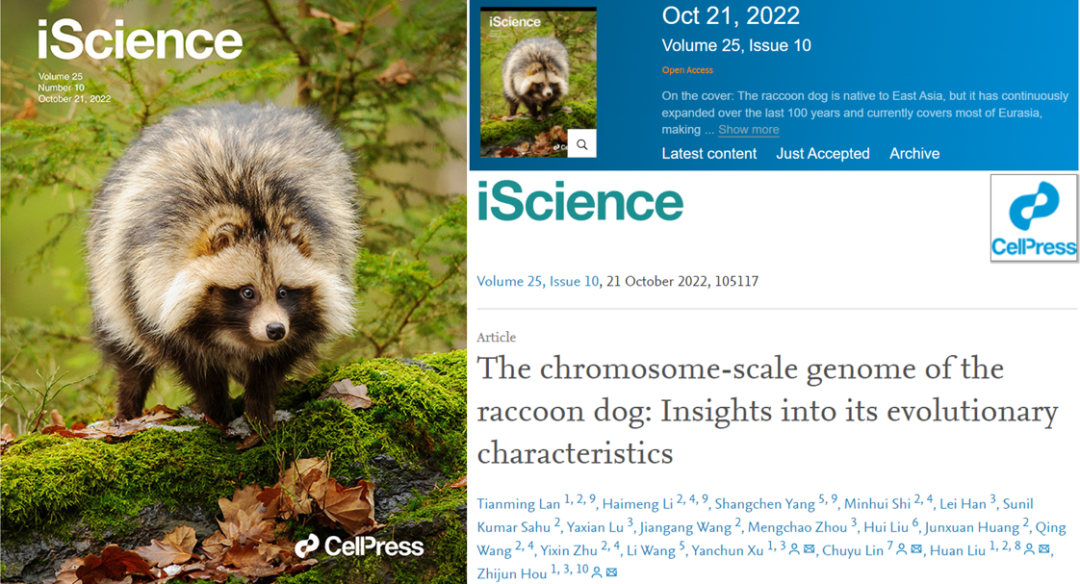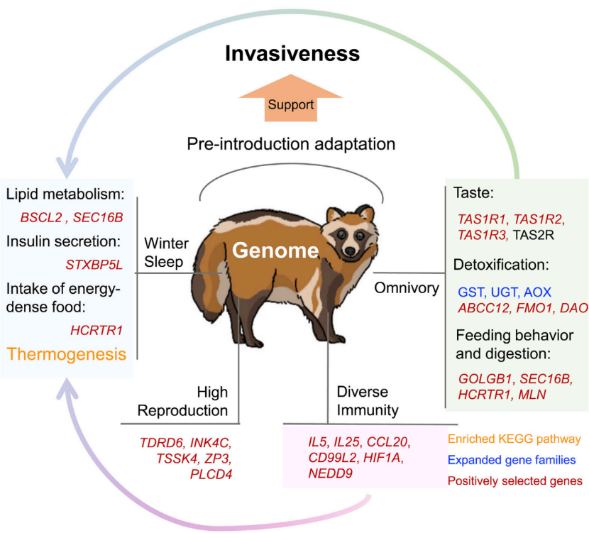Cuddly and fox-like, with fur markings resembling raccoons, the raccoon dog (Nyctereutes procyonoides) might well be mistaken for its mammalian counterpart. However, the feral animal is unrelated to raccoons – instead it is a member of the canine family and a close relative of foxes1,2.
Native to East Asia and introduced into parts of Russia and Europe due to demand for its pelt, the raccoon dog has an omnivorous diet that includes rodents, frogs, fish, insects, and plant matter. It is the only canine that hibernates3.
 The chromosome-scale genome of the raccoon dog: Insights into its evolutionary characteristics published on iScience as cover article.
The chromosome-scale genome of the raccoon dog: Insights into its evolutionary characteristics published on iScience as cover article.
Constructing an important genomic resource, BGI Group and Northeast Forestry University assembled the highest-quality Ussuri raccoon dog reference genome, successfully mapping the assembled genome backbone fragments to 27 chromosomes and identified sex chromosomes. In October, these research results were published in a cover article in iScience, a journal of Cell Press.
In the paper, researchers explored the possible genetic basis of the biological characteristics of raccoon dogs, including immunity, reproduction, omnivory, and winter sleep, which are prerequisites for the species to spread and adapt to habitats. This chromosome-scale genome of the raccoon dog provides a valuable resource for understanding the evolutionary characteristics of this species.
 Biological characteristics and related genetic basis of ecological invasion of raccoon dog.
Biological characteristics and related genetic basis of ecological invasion of raccoon dog.
In particular, the study suggested the raccoon dog species was able to multiply quickly across continents and acclimatize to different environments largely because of its biological characteristics. In particular, its omnivorous and diverse diet helps it adjust to different habitats and seasons, while its hibernation during winter enables it to survive harsh conditions, including food deprivation and cold weather.
At the same time, the raccoon dog has a genetic mechanism that enables it to carry a large number of pathogenic microorganisms – the animal is a well-known reservoir host for many pathogens – but often remains asymptomatic, without signs of illness. Researchers also found a large proportion of immune-related genes that were under strong positive selection, which, to a certain extent, explains the diverse immune system of this species.
Such valuable findings from this comprehensive study on the raccoon dog will provide a useful repository of knowledge for scientists, advancing future research on the evolution, ecology and management of wild populations of this species.
Read the research article: https://www.sciencedirect.com/science/article/pii/S258900422201389X
Reference:
1. https://www.britannica.com/animal/raccoon-dog
2. https://animalia.bio/raccoon-dog
3. https://www.ecologyasia.com/verts/mammals/raccoon-dog.htm



